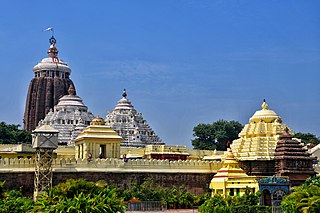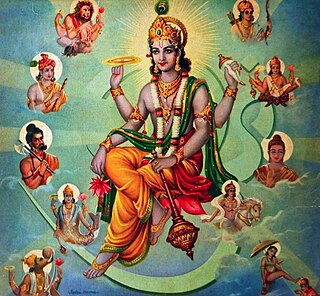
Jagannatha is a deity worshipped in regional Hindu traditions in India and Bangladesh as part of a triad along with his brother Balabhadra, and sister, Subhadra. Jagannath, within Odia Hinduism, is the supreme god, Purushottama, and the Para Brahman. To most Vaishnava Hindus, particularly the Krishnaites, Jagannath is an abstract representation of Krishna, or Vishnu, sometimes as the avatar of Krishna or Vishnu. To some Shaiva and Shakta Hindus, he is a symmetry-filled tantric form of Bhairava, a fierce manifestation of Shiva associated with annihilation.

The Smartatradition, also called Smartism, is a movement in Hinduism that developed and expanded with the Puranas genre of literature. It reflects a synthesis of four philosophical strands, namely Uttara Mīmāṃsā, Advaita, Yoga, and theism. The Smarta tradition rejects theistic sectarianism, and is notable for the domestic worship of five shrines with five deities, all treated as equal – Ganesha, Shiva, Shakti, Vishnu and Surya. The Smarta tradition contrasted with the older Shrauta tradition, which was based on elaborate rituals and rites. There has been a considerable overlap in the ideas and practices of the Smarta tradition with other significant historic movements within Hinduism, namely Shaivism, Brahmanism, Vaishnavism, and Shaktism.

The Jagannath Temple is an important Hindu temple dedicated to Jagannath, a form of Vishnu – one of the trinity of supreme divinity in Hinduism. Puri is in the state of Odisha, on the eastern coast of India. King Indradyumna of Avanti has built the main temple of Jagannath at Puri. The present temple was rebuilt from the tenth 10th century onwards, on the site of pre-existing temples in the compound but not the main Jagannatha temple, and begun by Anantavarman Chodaganga, the first king of the Eastern Ganga dynasty. many rumours are spread about the temple but there is no solid proof of it. The temple is one of the 108 Abhimana Kshethram of Vaishnavate tradition.

Vaishnavism is one of the major Hindu denominations along with Shaivism, Shaktism, and Smartism. It is also called Vishnuism since it considers Vishnu as the sole supreme being leading all other Hindu deities, that is, Mahavishnu. Its followers are called Vaishnavites or Vaishnavas, and it includes sub-sects like Krishnaism and Ramaism, which consider Krishna and Rama as the supreme beings respectively. According to a 2010 estimate by Johnson and Grim, Vaishnavism is the largest Hindu sect, constituting about 641 million or 67.6% of Hindus.

Krishnaism is a term used in scholarly circles to describe large group of independent Hindu traditions—sampradayas related to Vaishnavism—that center on the devotion to Krishna as Svayam Bhagavan, Ishvara, Para Brahman, who is the source of all reality, not an avatar of Vishnu. This is its difference from such Vaishnavite groupings as Sri Vaishnavism, Sadh Vaishnavism, Ramaism, Radhaism, Sitaism etc. There is also a personal Krishnaism, that is devotion to Krishna outside of any tradition and community, as in the case of the saint-poet Meera Bai. Leading scholars do not define Krishnaism as a suborder or offshoot of Vaishnavism, considering it at least a parallel and no less ancient current of Hinduism.

Bhima Bhoi (1850–1895) was a 19th-century saint, poet, mystic, and social reformer from the state of Odisha in India. He was a follower of Mahima Swami, and his teachings and poetry were deeply influenced by Mahima Dharma, a monotheistic religious movement in Odisha. Bhima Bhoi was a bhakta of Mahima Gosain, the founder of Satya Mahima Dharma, an Indian religious tradition that challenged the authority of caste and other forms of discrimination. Bhima Bhoi is remembered for his mystical poetry, which was primarily in the Odia language, and his social reform efforts aimed at uplifting the marginalized sections of society.
Satya Mahima Dharma is a religious tradition from Orissa. It goes back to a historic person called Mahima Svami.
Anncharlott Eschmann was a scholar of religion.

MahapurusaAchyutananda Dasa (Odia:-ଅଚ୍ୟୁତାନନ୍ଦ ଦାସ ) was a 16th-century poet seer and Vaishnava saint from Odisha, India. He was popularly known as Gopala Guru. He was considered to have the power to see the past, present and future. He was a prolific author, and one of the group of five, that led a revolution in spirituality in Odisha by translating Sanskrit texts into the Odia language for common people.
Odisha is one of the 28 states of India, located on the eastern coast. It is surrounded by the states of West Bengal to the northeast, Jharkhand to the north, Chhattisgarh to the west and northwest, and Andhra Pradesh to the south and southwest. Odia is the official and most widely spoken language, spoken by 33.2 million according to the 2001 Census. The modern state of Odisha was established on 1 April 1936, as a province in British India, and consisted predominantly of Odia-speaking regions. April 1 is celebrated as Odisha Day.

The Char Dham, also rendered the Chatur Dhama is a set of four pilgrimage sites in India. Since the establishment of the Char Dham temples, visiting these sites has become a path to achieve moksha. The four Dhams are Badrinath, Dwarka, Puri and Rameswaram.

Alarnatha Temple or Alvarnaatha, is a Hindu temple dedicated to Vishnu and located in Brahmagiri, Odisha, near Puri. It becomes crowded during the krishnapaksha of Ashadha, after the Snana Yatra when devotees are not allowed to see the central icon of Jagannath in his Puri temple. During this period, popularly known as Anasara or 'Anavasara', instead of having darshan in the Puri temple, devotees believe that Jagannath during this time manifests as Alarnath Dev, at the Alarnath temple in Brahmagiri, which is about 23 km from Puri. It is considered one among the 108 Abhimana Kshethram of Vaishnavate tradition.

Joranda Gadhi is a temple built in a location where three villages meet: Joranda, Natima and Patna. The temple is dedicated to the supreme lord. The followers of mahima dharma worship him as Sunya Brahma or the shapeless lord. No idol worship is permitted in this sect. The temple is dedicated to the supreme lord. Many people of other sects believe that the followers of this sect worship Surya, the sun god, but it is absolutely false. They just pray to the supreme lord facing to the direction of surya because it fixes the direction of concentration. One can choose one's own fix direction apart from east and west, but once fixed it cannot be changed.
Odisha, is an eastern Indian state on the Bay of Bengal. It is known for its tribal cultures and its many ancient Hindu temples. During the ancient times, many small kingdoms existed now known as Western Odisha, which was ruled by local chieftains.Western Odisha, or the western part of Odisha, India, extends from the Bolangir district in the south to the Sundargarh district in the north.

Swami Nigamananda Paramahansa was an Indian yogi, guru and mystic well known in Eastern India. He is associated with the Shakta tradition and viewed as a perfect spiritual master of vedanta, tantra, yoga and prema or bhakti. His followers idealized him as their worshipped and beloved thakura.
Dinakrushna Dasa was an Odia poet, belonging to the Vaishnava tradition of Bhakti movement. He is known for his Odia poem titled "Rasakallola", which is devoted to Lord Krishna. Among his many literary compositions, "Artatrana Chautisa" is a reputed one. Dinakrusna's Rasakallola and his standalone compositions including "chaupadi", "prabhati", "janana", "chautisa", "bhajana", and "malasri" are central to the repertoire of Odissi music, the traditional classical music of the state.

Gotipua is a traditional dance form in the state of Odisha, India, and the precursor of Odissi classical dance. It has been performed in Orissa for centuries by young boys, who dress as women to praise Jagannath and Krishna. The dance is executed by a group of boys who perform acrobatic figures inspired by the life of Radha and Krishna. The boys begin to learn the dance at an early age until adolescence, when their androgynous appearance changes. In the Odia language, Gotipua means "single boy" (goti-pua). Raghurajpur, Odisha is a historic village known for its Gotipua dance troupes. The dance of the Gotipuas is accompanied by traditional Odissi music with the primary percussion being the Mardala.
Pingua is a village in Dhenkanal district, Odisha, India.

The Bhoi dynasty or the Yaduvamsa dynasty were a medieval Hindu dynasty from the Indian subcontinent, which originated in the region of Odisha that reigned from 1541 to 1560 CE. Govinda Vidyadhara had usurped the throne from the later weaker Suryavamsa Gajapati Empire rulers as the kingdom started weakening but had a short-lived reign as ruling chiefs of Odisha as the ensuing internal rivalries and constant threats of invasions rendered them weak and were eventually overthrown by Mukunda Deva of Chalukya dynasty in 1560.

Aruna Stambha is a sixteen-sided 34 feet (10 m) tall monolithic chlorite stone Pillar having the idol of Aruna on the top. It is about twenty feet (6.1 m) away from the Singhdwara of Jagannath Temple in Puri.














